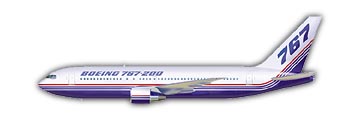The Boeing 767 family is a complete family of airplanes providing maximum market versatility in the 200- to 300-seat market. The Boeing 767 family includes three passenger models - the 767-200ER, 767-300ER and 767-400ER - and a freighter, which is based on the 767-300ER fuselage
The three passenger models differ primarily in body length, with the Boeing 767-300ER approximately 21 feet (6.43 m) longer than the 767-200ER, and the 767-400ER approximately 21 feet (6.43 m) longer than the 767-300ER. The twin-engine 767 - sized between the single-aisle 757 and the larger, twin-aisle 777 - has built a reputation among airlines for its profitability and comfort.
The Boeing 767's cabin is more than 4 feet (1.2 m) wider than single-aisle jetliners, and the 767's versatile design allows customers to select four, five, six, seven or eight abreast seating to best suit their operational requirements. The 767 seats from as few as 181 passengers in a three-class seating arrangement on the 767-200ER to as many as 375 passengers in a high-density charter configuration on a 767-400ER. The extended-range airplanes typically have three-class seating of 181 to 245 passengers, using five-abreast, 747-sized first class seats; six-abreast business class and seven-abreast economy class.
Lower-deck volume available for baggage and cargo ranges from 2,875 cubic feet (81.4 m3) for the 767-200 to 4,580 cubic feet (129.6 m3) for the 767-400ER.
All three passenger models are offered in a variety of takeoff weights, which allow operators to choose only the amount of design weight needed to satisfy their requirements. These offer corresponding design ranges from just over 5,645 nautical miles (10,440 km) to as many as 6,615 nautical miles (12,250 km). This range versatility gives the 767 family the ability to efficiently serve routes as short as U.S. domestic and pan-European to long-range flights over the North Atlantic and North Pacific. The 767 now crosses the Atlantic from the United States to Europe more often than any other jetliner. |

